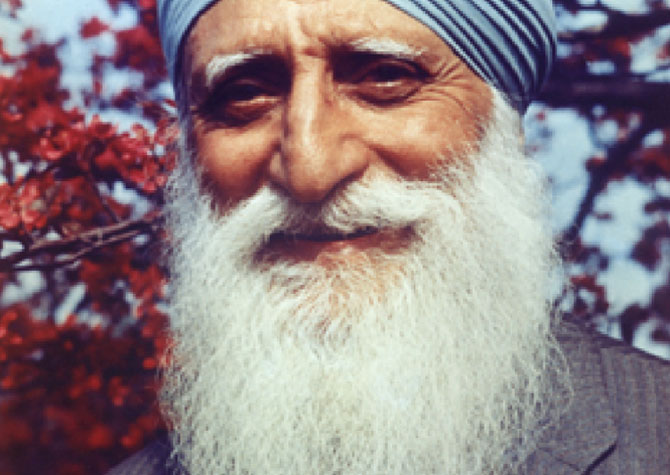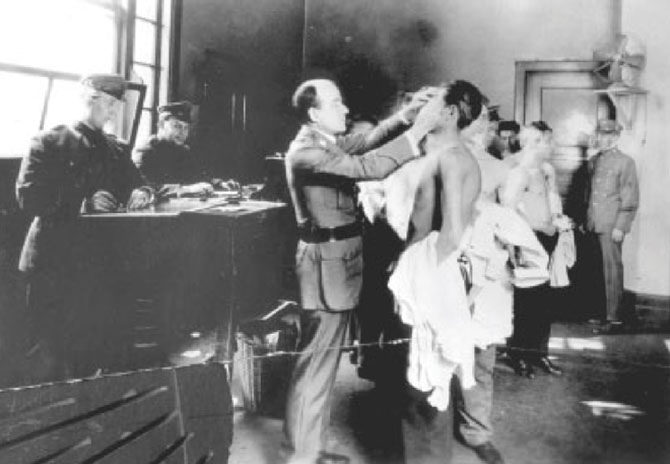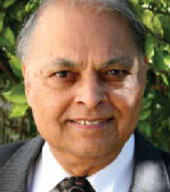In the annals of Asians’ struggle for US citizenship, Dr. Bhagat Singh Thind’s fight for citizenship occupies a prominent historical place. His US citizenship was rescinded four days after it was granted. Eleven months later, he received it for the second time but the US Immigration and Naturalization Service (INS) appealed to the Ninth Circuit Court of Appeals, which sent the case to the next higher court for ruling. Thind valiantly fought his case in the US Supreme Court, but the Justice revoked his citizenship simply due to the color of his skin. The Court verdict in Thind’s case, United States v. Thind confirmed that the rights and privileges of naturalization were reserved for “Whites” only.
At that time, Indians in the United States were commonly called “Hindoos” (“Hindus”) irrespective of their faith. Thind’s nationality was also referred to as “Hindoo” or “Hindu” in all legal documents and in the media although he was a Sikh by faith and preserved his religious beliefs by keeping a beard and having long hair wrapped in a turban.
The U.S. citizenship conferred many rights and privileges but only “free white men” were eligible to apply. In the United States, many anthropologists used Caucasian as a general term for “white.” Indian nationals from the north of the Indian Sub-Continent were also considered Caucasian. Thus, several Indians were granted US citizenship in different states. Thind also applied for citizenship in the state of Washington in July, 1918. He received his citizenship certificate on December 9, 1918 wearing military uniform as he was still serving in the US army. However, the INS did not agree with the district court granting his citizenship. Thind’s citizenship was revoked in four days, on December 13, 1918, on the grounds that he was not a “free white man.” Thind, as a soldier in the US army, had all the rights and privileges like any “white man” and was worthy of trust to defend the US but America would not trust him with citizenship rights because of the color of his skin.
Thind was disheartened but was not ready to give up his fight. He applied for citizenship again from the neighboring state of Oregon on May 6, 1919. The same INS official who got Thind’s citizenship revoked first time, tried to convince the Justice to refuse citizenship to a “Hindoo” from India. He even brought up the issue of Thind’s involvement in the Gadar Movement, members whom campaigned for the independence of India from Britain. But Thind contested this charge. Justice Wolverton believed him and observed, “He (Thind) stoutly denies that he was in any way connected with the alleged propaganda of the Gadar Press to violate the neutrality laws of this country, or that he was in sympathy with such a cause. He frankly admits, nevertheless, that he is an advocate of the principle of India for the Indians, and would like to see India rid of British rule, but not that he favors an armed revolution for the accomplishment of this purpose.” The Justice took all arguments and Thind’s military record into consideration and declined to agree with the INS. Thus, Thind received US citizenship for the second time on November 18, 1920.
The INS had included Thind’s involvement in the Gadar Movement as one of the reasons for the denial of US Citizenship. Gadar, which literally means revolt or mutiny, was the name of the magazine of Hindustan Association of the Pacific Coast. The magazine became so popular among Indians, that the association itself became known as the Gadar party.
The Hindustan Association of the Pacific Coast was formed in 1913 with the objective of freeing India from British rule. The majority of its supporters were Punjabis who had come to the US for better economic opportunities. They were unhappy with racial prejudice and discrimination against them. Indian students, who were welcomed in the universities, also faced discrimination in finding jobs commensurate with their qualifications upon graduation. They attributed prejudice, inequity and unfairness to their being nationals of a subjugated country. Har Dyal, a faculty member at Stanford University, who had relinquished his scholarship and studies at Oxford University, England, provided leadership for the newly formed association and channelized the pro-Indian, anti-British sentiment of the students for independence of India.
Soon after the formation of the Gadar party, World War I broke out in August 1914. The Germans, who fought against England in the war, offered the Indian Nationalists (Gadarites) financial aid to buy arms and ammunition to expel the British from India while the British Indian troops would be fighting war at the front. The Gadarite volunteers, however, did not succeed in their mission and were taken as captives upon reaching India. Several Gadarites were imprisoned; many for life, and some were hanged. In the United States too, many Gadarites and their German supporters, were prosecuted in the San Francisco Hindu German Conspiracy Trial (1917-18) and twenty-nine “Hindus” and Germans were convicted for varying terms of imprisonment by violating the American Neutrality Laws [www.sikhpioneers.org].
Thind, like many other Indian students, had joined the Gadar movement and actively advocated independence of India from the British Empire. Justice Wolverton granted him citizenship after he was convinced that Thind was not involved in any “subversive” activities.

Photo Caption
The INS appealed to a higher court – the Ninth Circuit Court of Appeals that sent the case to the US Supreme Court for ruling on the following two questions:
“1. Is a high caste Hindu of full Indian blood, born in Amritsar, Punjab, India, a white person within the meaning of section 2169, Revised Statutes?”
“2. Does the act of February 5, 1917 (39 Stat. L. 875, section 3) disqualify from naturalization as citizens those Hindus, now barred by that act, who had lawfully entered the United States prior to the passage of said act?”
Section 2169, Revised Statutes, provides that the provisions of the Naturalization Act “shall apply to aliens, being free white persons, and to aliens of African nativity and to persons of African descent.”
In preparing briefs for the Ninth Circuit Court, Thind’s attorney argued that the Immigration Act of 1917 barred new immigrants from India but did not deny citizenship to Indians who were legally admitted like Thind, prior to the passage of the new law. He argued that the purpose of the Immigration Act was “prospective and not retroactive.”
Thind’s attorney gave references of previous court cases of Indians who were granted citizenship by the lower federal courts on the grounds that they were Caucasians. (U.S. v. Dolla 1910, U.S. v. Balsara 1910, Akhay Kumar Mozumdar 1913, Mohan Singh, 1919). Justice Wolverton, in granting citizenship to Thind, also said, “The word ‘white’ ethnologically speaking was intended to be applied in its popular sense to denote at least the members of the white or Caucasian race of people.” Even the U.S. Supreme Court, in 1922, in the case of a Japanese immigrant, US vs. Ozawa, officially equated “white person” with “a person of the Caucasian race.”
Based on Ozawa’s straightforward ruling of racial specification and many similar previous court cases, Thind was convinced he would win the case and his victory will open doors for all Indians in the United States who wished to obtain US citizenship. Little did he know that the color of his skin would become the grounds for denial of the right of citizenship by the highest court in the US.
Justice George Sutherland of the Supreme Court delivered the unanimous opinion of the court on February 19, 1923, in which he argued that since the “common man’s” definition of “white” did not correspond to “Caucasian”, Indians could not be naturalized. The Justice , giving his verdict, said, “A negative answer must be given to the first question, which disposes of the case and renders an answer to the second question unnecessary, and it will be so certified.”
Shockingly, the very same Justice Sutherland who had equated Whites as Caucasians in US vs. Ozawa, now pronounced that Thind, though Caucasian, was not “White” and thus was ineligible for US citizenship. He apparently decided the case under pressure from the forces of prejudice, racial hatred and bigotry, not on the basis of precedent that he had established in a previous case. The decision, in essence, reinterpreted the proclamation, “Liberty and Justice for All” to mean “Liberty and Justice for Whites.”
The Supreme Court verdict shook the faith and trust of Indians in the American justice system. The economic impact for land and property-owning Indians was devastating as they again came under the jurisdiction of the California Alien Land Law of 1913 which barred ownership of land by persons ineligible for citizenship. Some Indians had to liquidate their land holdings at dramatically lower prices. America, the dreamland, did not fulfill the dream they had envisioned.
The INS issued a notification in 1926 canceling Thind’s citizenship for a second time. The INS also initiated proceedings to rescind American citizenship of other Indians. From 1923 to 1926, the citizenship of fifty Indians was revoked. The Barred Zone Act of 1917 had already prevented new immigration of Indians. The continued shadow of insecurity and instability compelled some to go back to India. The Supreme Court decision further lead to the decline in the number of Indians to 3130 by 1930. [From India to America; Garry Hess, p 31]
There probably was little sympathy for treating “Hindu Thind” shabbily, but there was a concern for the poor treatment of “US Army Veteran Thind.” Thus in 1935, the 74th US Congress passed a law allowing citizenship to US veterans of World War I, even those from the ‘barred zones’. Dr. Thind finally received his U.S. citizenship through the state of New York in 1936, taking oath for the third time to become an American citizen. This time, no official of the INS dared to object or appeal against his naturalization.
Thind had come to the US for higher education and to “fulfill his destiny as a spiritual teacher.” Long before his or any other religious teachers or yogis arrival from India, American intellectuals had shown a keen interest in Indian religious philosophy. Hindu sacred books translated by the English missionaries had made their way to America and were the “favorite texts” of many members of the Transcendentalists’ society (which was started by some American thinkers and intellectuals who were dissatisfied with spiritual inadequacy of the Unitarian Church). The society flourished during the period of 1836-1860 in the Boston area and had some prominent and influential members including author and philosopher Ralph Waldo Emerson (1803-1882), poet Walter Whitman (1819-1892), and writer Henry David Thoreau (1817-1862).

Immigrants being inspected at Angel Island, CA in the beginning of the 20th Century
Emerson had read Hindu religious and philosophy texts, including the Bhagavad Gita, and his writings reflected the influence of Indian philosophy. In 1836, he expressed “mystical unity of nature” in his essay, “Nature.” In 1868, Walt Whitman wrote the poem “Passage to India.” Henry David Thoreau had considerable acquaintance with Indian philosophical works. He wrote an essay on “Resistance to Civil Government, or Civil Disobedience” in 1849 advocating non-violent resistance against unethical government laws. Years later, Mahatma Gandhiji adopted similar methodology, satyagraha, or non-violent protest to defy the law to gain Indian rights in South Africa in 1906. He quoted Thoreau many times in his paper, Indian Opinion.
In 1893, Swami Vivekananda came to Chicago to represent Hinduism at the World Parliament of Religions. He spoke very eloquently and made a lasting impact on the delegates. For four years, he lectured at major universities and retreats and generated significant interest in yoga and Vedantic philosophy. He also started the Vedantic Centre in New York City. In 1897, he published his book “Vedanta Philosophy: Lectures on Raja Yoga and Other Subjects.” The first part of his book included lectures to students in New York and the second part contained translation and commentary of “Patanjali.” [Pradhan:India in the United States]
Swami Vivekananda’s constant teaching, lecturing and addressing retreats increased the number of Americans who became receptive to learn about India, the Hindu religion and philosophy. Some publishers published books to meet the growing interest of the American people. Scribner, Armstrong & Co published “India and its Native Princes”, a 580-page illustrated coffee-table book. C.H. Forbes-Lindsay of Philadelphia in October, 1903 published “India – Past and Present” in two volumes. The Yogi Publication Society of Chicago published many books such as The Hindu-Yogi Science of Breath (1905), A Series of Lessons in Raja Yoga (1906), Bhagavad Gita (1907), etc.
After Swami Vivekananda left, other religious leaders came to fill the void. 1920, Swami Paramahansa Yogananda came as India’s delegate to the International Congress of Religious Leaders in Boston. The same year, he established The Self-Realization Fellowship and continued to spread his teachings on yoga and meditation on the East Coast. In 1925, he established an international headquarters for the Self-Realization Fellowship in Los Angeles. He traveled widely and lectured to full capacity audiences in many of the largest auditoriums in the country such as New York’s Carnegie Hall. (www.yogananda-srf.org)
Thind had started delivering lectures on Indian philosophy and metaphysics even before Swami Yogananda came here. He was influenced by the spiritual teachings of his father whose “living example left an indelible blueprint in him.” During his formative years in India, Thind read the literary writings of Emerson, Whitman, and Thoreau and they too had deeply impressed him. After graduating from Khalsa College in Amritsar, Punjab, and encouraged by his father, he left for Manila, Philippines where he stayed for a year. He resumed his journey and reached his destination, Seattle, Washington, on July 4, 1913.
Bhagat Singh Thind had gained some understanding of the American mind by interacting with students and teachers at the university and by working in lumber mills of Oregon and Washington during summer vacations to support himself while at the University of California, Berkeley. His teachings included the philosophy of many religions, and in particular the Sikh Scriptures. During his lectures, discourses and classes to Christian audiences, he frequently quoted the Vedas, Guru Nanak, Kabir, and others. He generously shared India’s mystical, spiritual and philosophical treasures with his students but never converted or persuaded any of them to become Hindu or Sikh. He also made references to Ralph Waldo Emerson, Walt Whitman, and Henry David Thoreau which his American audience could easily relate to.
Dr. Thind gave a new “vista of awareness” to his students throughout the United States and initiated thousands of disciples into his expanded view of reality – “the Inner Life, and the discovery of the power of the Holy Næm.” One of his devoted disciples was Rosalind Elena Davies who started following Dr. Thind’s teachings in the mid 1930’s. In 1938, she introduced her daughter Vivian to her spiritual teacher, Dr. Thind. Vivian and Bhagat Singh were married in 1940.
Thind, who had earned a Ph.D, became a prolific writer and was respected as “spiritual guide.” He published many pamphlets and books and reached an audience of at least five million. The list of his books include “Radiant Road to Reality”, “Science of Union with God” , “The Pearl of Greatest Price”, “House of Happiness”, “Jesus, The Christ: In the Light of Spiritual Science (Vol. I, II, III)”, “The Enlightened Life”, “Tested Universal Science of Individual Meditation in Sikh Religion”, “Divine Wisdom in three volumes.. [www.Bhagatsinghthind.com]”
In “RADIANT ROAD TO REALITY”, Dr. Thind reveals to the seeker how to connect the soul with the Creator. “There are many religions, but only one Morality, one Truth, and one God. The only Heaven is one of conscious life and fellowship with God,” explains Dr. Thind. He wrote, “JESUS, THE CHRIST: In the Light of Spiritual Science” in three volumes for those, “who have freed themselves of orthodox religious thinking. The books serve as a springboard to greater spiritual heights, wherein we appreciate more than ever the message of the Sat Gurus, the Saviors, the Avatars, the Christs, of whom Jesus Christ was one.”
Dr. Thind was working on some books when suddenly he died on September 15, 1967. He was survived by his wife, Vivian, daughter, Rosalind and son, David, to whom several of his books are dedicated. He never established a temple, Gurdwara or a center for his followers but lived for a long time in the hearts of his numerous followers.
David Thind has established a website www.BhagatSinghThind.com to promote and propagate his father’s books and the philosophy Dr. Thind produced and disseminated throughout his entire life in the United States. He has also posthumously published two of his father’s books, “Troubled Mind in a Torturing World and their Conquests,” and “Winners and Whiners in this Whirling World” and is working on some others.
Dr. Bhagat Singh Thind said, “You must never be limited by external authority, whether it be vested in a church, man, or book. It is your right to question, challenge, and investigate.” And he lived his life by that statement. He was a man of indomitable spirit and waged a valiant struggle for citizenship. He extended the boundaries of his fight by challenging the forces of race and color. Unfortunately, even the highest US court could not rise above the low level of skin color, yet his legacy lives on in his dream land that refused to acknowledge him at first.

Inder Singh is chairman of Indian American Heritage Foundation, president of Global Organization of People of Indian Origin (GOPIO International), former president of NFIA and founder president of FIA of Southern California. He can be reached by email at indersingh-usa@hotmail.com or by telephone at 818 708-3885.
